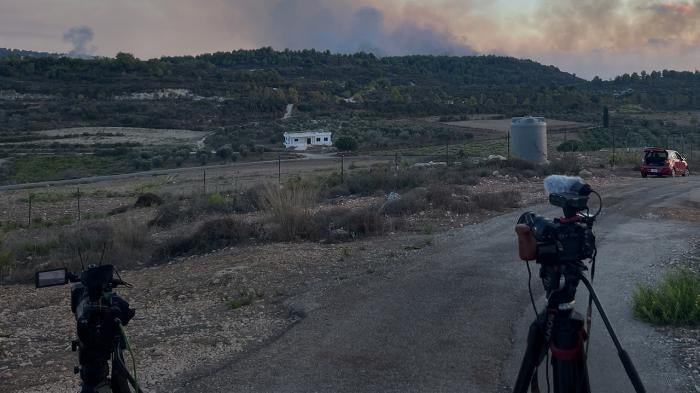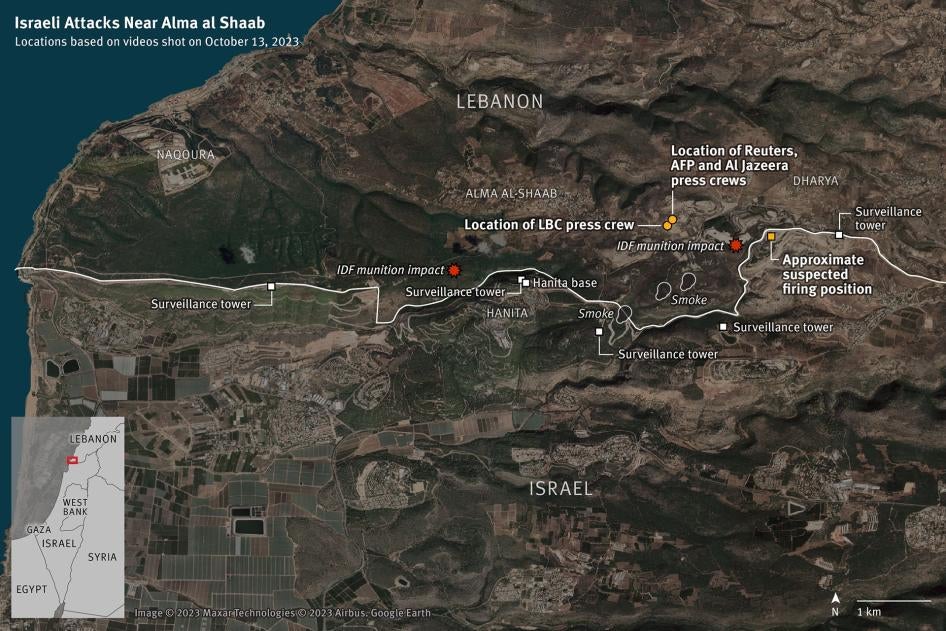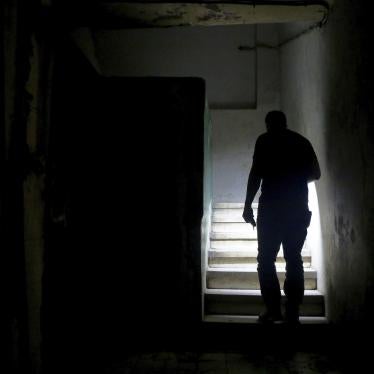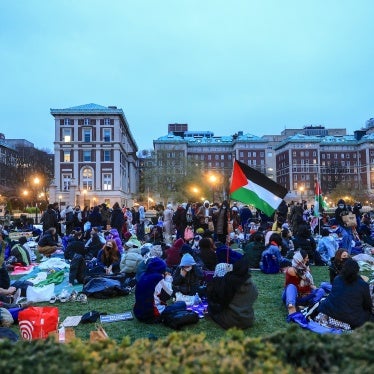- Two Israeli strikes on a group of Lebanese, American, and Iraqi journalists in south Lebanon on October 13, 2023, were apparently deliberate attacks on civilians, which is a war crime.
- Evidence indicates that the Israeli military knew or should have known that the group of people they were firing on were civilians.
- Israel's key allies – the United States, the United Kingdom, Canada, and Germany – should suspend military assistance and arms sales to Israel, given the risk they will be used for grave abuses.
(Beirut) – Two Israeli strikes in Lebanon on October 13, 2023, that killed Reuters journalist Issam Abdallah and injured six other journalists was an apparently deliberate attack on civilians and thus a war crime, Human Rights Watch said today.
Witness accounts and video and photo evidence that Human Rights Watch verified indicate that the journalists were well removed from ongoing hostilities, clearly identifiable as members of the media, and had been stationary for at least 75 minutes before they were hit by two consecutive strikes. Human Rights Watch found no evidence of a military target near the journalists’ location.
“This is not the first time that Israeli forces have apparently deliberately attacked journalists, with deadly and devastating results,” said Ramzi Kaiss, Lebanon researcher at Human Rights Watch. “Those responsible need to be held to account, and it needs to be made clear that journalists and other civilians are not lawful targets.”
Human Rights Watch interviewed seven witnesses, including three of the injured journalists, and analyzed 49 videos and dozens of photos, in addition to satellite images. Human Rights Watch also interviewed a United Nations Interim Forces in Lebanon (UNIFIL) representative and consulted military, video, and audio experts. On October 17 and 26, Human Rights Watch sent letters with findings and questions to the Lebanese and Israeli armed forces, respectively, but did not receive a response from either.
Evidence reviewed by Human Rights Watch indicates that the Israeli military knew or should have known that the group of people they were firing on were civilians.
On October 14, an Israeli military spokesperson, Richard Hecht, said that they were “very sorry for the journalist’s death.” On October 17, Hecht told Reuters that the military was “looking at the footage and [will] come out with an answer when we’re ready.” But that has not happened.
Video evidence, expert audio analysis, and witness accounts suggest that the group was visible to the cameras of a nearby unmanned aerial vehicle (UAV) that was most likely Israeli, within line of sight of five Israeli surveillance towers, and most likely targeted by at least one munition fired from the main gun of a tank from an Israeli military position approximately 1.5 kilometers southeast. Human Rights Watch was unable to identify the second munition that struck the journalists.
The attacks occurred at around 6:00 p.m. on October 13. The group of journalists had congregated, as early as 4:45 p.m., in a clearing on a hilltop in Alma al-Shaab, to film ongoing fighting at Lebanon’s southern border with Israel, people interviewed said. About an hour before the attacks, a suspected infiltration attempt by armed militants from Lebanon into the Israeli town of Hanita, approximately 2.2 kilometers away, was followed by cross-border fire between Israeli forces and armed groups.
Israeli military officials told Reuters that Hezbollah fired at several border locations, including with “an anti-tank missile that hit the Israel security fence.” In a statement that day, UNIFIL said that “a heavy exchange of fire erupted between Lebanon and Israel in the vicinity of Alma Shaab, Ayta Ash Shab, Al Dihaira, El Adeysse and Houla” at approximately 5:20 p.m. Forty minutes later, two munitions struck the journalists’ location. Five cameras belonging to journalists indirectly captured the attack and its aftermath, shedding light on how the attack was carried out and from where.
The journalists interviewed said that the first munition struck Reuters journalist Issam Abdallah and a short concrete wall, killing him instantly and badly injuring an Agence France-Presse (AFP) photojournalist, Christina Assi. Thirty-seven seconds later, another attack destroyed the car belonging to Al Jazeera, igniting it in flames, and injuring six journalists, including Carmen Joukhadar and Elie Brakhya from Al Jazeera, Dylan Collins and Christina Assi from AFP, and Thaer al-Sudani and Maher Nazeh from Reuters.
Collins, Joukhadar, and Brakhya told Human Rights Watch that all seven journalists were wearing helmets and blue ballistic vests with labels that said “PRESS,” and were clearly identifiable as journalists. This was confirmed through videos Human Rights Watch analyzed. One video, posted to Assi’s Instagram account at least an hour before the attack, shows five journalists, including Abdallah, wearing the blue ballistic vests and helmets with clearly visible labels. Other footage also shows the group wearing the clearly marked vests and helmets in the same area, near a car marked with “TV” in large letters on its hood.
The journalists were stationary at this exposed site, within a line of sight to an Israeli military location in north Israel, 2.2 kilometers away, for at least 1 hour and 15 minutes, according to their statements and video evidence. Journalists from Al Jazeera had conducted two live TV reports, the first at 4:55 p.m. and the second at 5:24 p.m., from the same location. Live transmissions by Reuters and AFP were also broadcast on air by several television stations during that period.
Human Rights Watch confirmed the presence of a helicopter south of the journalists’ position, one hour, 30 minutes, and 5 minutes before the strike, in videos it reviewed. Witness statements and statements made by reporters who were broadcasting live at the time indicated that a helicopter was flying overhead for various periods before the first strike, including in the last 15 minutes and one minute before the attack.
Witness statements and audio analysis of videos by two teams of experts consulted by Human Rights Watch, including the nongovernmental group Earshot and a US-based expert, identified the presence of a propeller-driven unmanned aerial vehicle before the first strike. According to two experts’ audio analysis, the vehicle circled near the journalists’ position 11 times in the 25 minutes prior to the strikes. A third analysis by a UK group of audio experts found that the sound was consistent with that of an electric motor circling the journalists’ position before the first strike, and could be evidence of a propellor-driven UAV.
All evidence reviewed indicated that the journalists were not near areas with ongoing hostilities. In 49 videos Human Rights Watch analyzed and geolocated, researchers found that the journalists were between one and two kilometers from areas where hostilities were reported. All witnesses said that airstrikes and armed clashes between Israeli forces and Hezbollah and Palestinian armed groups were concentrated in the area near the border fence, between one and two kilometers from the journalists.
None of the evidence indicated the presence of any military objective near the journalists. The attack on the journalists’ position directly targeted them, with two consecutive strikes within 37 seconds.
A witness in Alma al-Shaab said that he saw two red streaks striking the journalists’ location from a hilltop area near Jordeikh in northern Israel, about 1.5 kilometers from the journalists’ position. Satellite images of a clearing approximately 1.5 kilometers southeast of the journalists’ location, in Jordeikh, recorded on the mornings of October 12, 13, and 14, confirm the presence of military activity at this position.
A fundamental tenet of international humanitarian law, or the laws of war, is that of “civilian immunity.” It imposes a duty, at all times during the conflict, to target only combatants and other military objectives. It is forbidden in any circumstance to carry out direct attacks against civilians. Journalists benefit from the general protection enjoyed by civilians and may not be targets of an attack unless they are taking direct part in hostilities.
Warring parties are obligated to take all feasible precautions to avoid harm to civilians. They must take all necessary action to verify that targets are military objectives.
A person who commits serious violations of the laws of war with criminal intent – that is, intentionally or recklessly – may be prosecuted for war crimes. Individuals may also be held criminally liable for assisting in, facilitating, aiding, or abetting a war crime.
Israel’s key allies – the United States, the United Kingdom, Canada, and Germany – should suspend military assistance and arms sales to Israel, given the real risk that they will be used to commit grave abuses. US policy prohibits arms transfers to states “more likely than not” to use them in violations of international law. The United States government should investigate the strike in light of injuries caused to one of its citizens.
“The evidence strongly suggests that Israeli forces knew or should have known that the group that they were attacking were journalists,” Kaiss said. “This was an unlawful and apparently deliberate attack on a very visible group of journalists.”
Background
The Israeli strikes are taking place in the context of increased tensions along the Lebanon-Israeli border. Rocket and missile attacks and armed clashes between the Israeli army and various Palestinian and Lebanese armed groups, including Hezbollah, have been ongoing since October 8, the day after the Hamas-led attack in southern Israel resulted in the killing of about 1,200 people, mostly civilians, according to the Israeli government. Hamas and Islamic Jihad took more than 200 people hostage, including children, people with disabilities, and older people.
As of December 5, more than 16,200 people, including thousands of civilians, and more than 7,100 children have been killed, and more than 1.8 million people displaced, amid heavy bombardment and military operations in Gaza by Israeli forces since October 7. Israeli authorities have cut electricity, water, fuel, and food to the civilian population in Gaza, which amounts to collective punishment. This exacerbated an already dire humanitarian situation that existed as a result of Israel’s 16-year unlawful closure, which is part of the crimes against humanity of apartheid and persecution being committed by Israeli authorities against Palestinians. In the West Bank, Israeli forces and settlers have killed 243 Palestinians between October 7 and December 3, according to the UN Office for the Coordination of Humanitarian Affairs (OCHA).
Since October 7, Israeli attacks have killed at least 56 Palestinian journalists, mostly in Gaza, and at least 4 Israeli journalists were killed in the Hamas-led attacks in southern Israel on October 7, according to the Committee to Protect Journalists (CPJ). The organization said that the first month of the hostilities in Israel and Gaza was “the deadliest month for journalists” since the organization began documenting journalist fatalities in 1992.
Human Rights Watch verified the use of artillery projectiles containing white phosphorous in south Lebanon by Israeli forces, in addition to an indiscriminate attack on civilians on November 5, amounting to a possible war crime. Israeli forces also used white phosphorous in the densely populated Gaza city port, as Human Rights Watch documented. As of November 23, Israeli attacks in Lebanon have reportedly killed at least 15 civilians, according to an AFP tally, in addition to at least 85 Hezbollah fighters, according to media reports. Rocket and missile strikes and other attacks into Israel by Hezbollah and armed Palestinian groups in Lebanon have reportedly killed at least three civilians and six soldiers.
Hezbollah’s secretary general, Hassan Nasrallah, suggested in a televised speech on November 3 that attacks by Israel on civilians in Lebanon would be met with retaliatory attacks on civilians in Israel. Under international humanitarian law, belligerent reprisals against civilians are prohibited. Parties to a conflict are obligated to abide by international humanitarian law irrespective of the conduct of other parties. Laws-of-war violations by one party do not justify violations by another.
In total, three Lebanese journalists had been killed by Israeli strikes as of November 21, according to the CPJ. On November 21, two Lebanese journalists, Rabih Al-Maamari and Farah Omar, along with their driver, Hussein Akil, were reported killed in an Israeli strike in the southern Lebanese town of Tayr Harfa, 2.3 kilometers from where Issam Abdallah was killed. The journalists were reporting for Al Mayadeen TV, a Lebanon-based pan-Arab television station politically allied with Hezbollah and the Syrian government.
October 13 Timeline of Key Events
The following timeline is based on analysis conducted by Human Rights Watch’s Digital Investigations Lab and other researchers of 49 videos, dozens of photographs, witness statements, and media reports from October 13, the day of the attack.
4:45 p.m. After filming in Naqoura, in southern Lebanon, the crew from Al Jazeera, consisting of Carmen Joukhadar, a reporter, and Elie Brakhya, a cameraman, arrives on site at the hilltop in Alma al-Shaab. They set up their cameras and prepare to go live.
4:55 p.m. The Al Jazeera team broadcasts their first live coverage. Joukhadar can be heard on video saying that Israeli tank fire was reported in Alma al-Shaab but that, according to Lebanese security sources, no rockets were fired from Lebanon, despite reports of infiltration attempts into Israel by armed groups. The impact of the strikes is captured on camera in several locations across the Lebanon-Israel border. Human Rights Watch confirmed the site of the strikes captured on camera to be about 1-2 kilometers away from the journalists. Joukhadar says that helicopters can be heard flying in the air, and Brakhya captures on camera a helicopter flying over the border area.
Around 5 p.m. The Reuters and AFP crews, consisting of Issam Abdallah, Maher Nazeh, Thaer al-Sudani, Dylan Collins, and Christina Assi, join Al Jazeera at Alma al-Shaab.
5:03 p.m. The Israeli military shares a post on Telegram saying that a “short while ago, there was an explosion at the security fence adjacent to the community of Hanita,” which was lightly damaged, and that they are responding with artillery fire toward Lebanese territory. The Israeli military adds that there has been an infiltration into Hanita and Israeli soldiers are searching the area.
5:24 p.m. The Al Jazeera team broadcasts their second live coverage on site. Joukhadar can be heard saying that, after a pause of a few minutes, Israeli strikes on the area near Alma al-Shaab have resumed, hitting areas from southwest Lebanon in Naqoura to Alma al-Shaab. Joukhadar says that there has been a failed infiltration attempt into Israel from Lebanon, to which Israeli forces responded with tank fire into areas near the border fence. Joukhadar also says that an Israeli helicopter and an unmanned aerial vehicle can be heard flying over Alma al-Shaab. The Al Jazeera camera captures several strikes across various areas in Alma al-Shaab. Human Rights Watch geolocated the strikes’ impact areas to be between 1 and 2 kilometers from the site.
Around 5:40 p.m. A Reuters camera captures the sound of tank fire, and smoke is seen billowing up from a location approximately 1.5 kilometers from the journalists.
5:53 p.m. The Israeli military shares a post on Telegram saying that “a short while ago, incoming fire was identified from Lebanon toward Israeli territory by the Lebanese border” and that Israeli soldiers are responding with tank and artillery fire toward the source of the live fire. The Times of Israel reported that the gunfire was identified to be around the town of Misgav Am, which is 35 kilometers from the journalists.
5:54 p.m. Elie Brakhya, the Al Jazeera cameraman, sends a selfie of himself and Issam Abdallah to a WhatsApp group chat. In the photo, both Brakhya and Abdallah are wearing blue ballistic vests with “PRESS” labels and helmets. The AFP photojournalist, Christina Assi, can be seen behind them sitting on the short concrete wall that was later struck.
5:58 p.m. A Reuters camera pans over to the Israeli military location at Hanita. A tank can be seen firing off a round to an area in southwest Lebanon, approximately 3 kilometers from the journalists. The tank then moves downhill and out of sight.
6:02 p.m. The AFP journalist, Dylan Collins, pulls out his phone and films, with an iPhone 12 Pro Max, the Hanita military location. His phone camera captures quick and successive flashes of light, coming from the military location. Two TV cameras filming from the same location recorded this light as static, not blinking. In a video from a fourth camera, a mirrorless camera that recorded the same scene from the exact same location, the light is not visible. Experts say that the discrepancy among four cameras shooting the exact same scene could be proof that the light in question is near-infrared light and could be evidence of the use of lasers used for targeting or range-finding from the Israeli position.
These four cameras were all pointed toward the Israeli military location in Hanita and recorded as the munitions struck their location. A loud explosion is heard, followed by screams coming from the journalists on site. Thirty-seven seconds later another munition landed on the journalists’ position.
A live feed by the Lebanese Broadcasting Corporation International (LBCI) TV crew, about 120 meters from the journalists, also captured the sound of both strikes hitting the journalists. Thirty seconds before the strike, an LBCI reporter can be heard saying that an Apache helicopter is flying in circles over the area, as well as an unmanned aerial vehicle, and a reporter can be heard saying that fire from automatic weapons can be heard for the first time, which are not audible on their live feed. After the second strike, LBCI’s camera panned over to the location of the AFP, Reuters, and Al Jazeera journalists. Fire and black smoke can be seen billowing from the site.
The LBCI TV crew temporarily cut their coverage and then continued filming from the site of the strike. After the filming resumed, minutes later, an ambulance and civil defense truck can be seen on site. A crater near the car’s engine on the driver’s side is clearly visible as well. Issam Abdallah’s body is seen lying on the ground, behind a short concrete rock wall.
Weapons Analysis
Photos of the remnants, reviewed by Human Rights Watch and confirmed to have been found at the site of the strike, show that one of the munitions that struck the journalists was a fin-stabilized 120mm tank shell. The remnants of the shell were located a few meters away from Abdallah’s body.
Human Rights Watch could not identify the remnants of the second munition.
Audio Analysis
Expert audio analysis by two independent groups indicates that the launch site for the first munition was between 1.45 and 1.8 kilometers from the journalists’ location and most likely fired from the southeast. The location identified by the witnesses, Jordeikh in northern Israel, is approximately 1.5 kilometers southeast of the journalists’ location.
Thirty seconds after the second strike, cameras recorded audio of small arms rounds being fired from an unidentified source. Expert audio analysis and witness statements indicate that the bullet rounds did not originate from a site near the journalists. Audio experts’ analyses suggest that the source of fire was hundreds of meters away, but the exact distance could not be calculated. In interviews, witnesses at the site all said that the sounds of the bullets appeared to have come from the direction of the Israeli military location near Hanita, southwest of the journalists’ location. Human Rights Watch could not definitively verify the location from which the bullets were fired.
Expert audio analysis also identified the sound of an unmanned aerial vehicle above the journalists and indicated that it circled near the journalists’ position 11 times in the 25 minutes before the first strike. Witnesses at the site all said that they could hear a drone above them. Human Rights Watch was not able to independently determine the make of the aerial vehicle.
The movement of the aerial vehicle over the journalists and its flight pattern in proximity to an Israeli Apache helicopter, in addition to documented reports of Israeli UAV flights over south Lebanon, suggest that the vehicle is likely Israeli. At 7:40 p.m., on October 13, the Israeli military shared a post on social media stating that “An IDF UAV is currently striking terrorist targets belonging to Hezbollah in Lebanon.” A November 2023 UNIFIL report indicated that Israeli UAV flights over south Lebanon accounted for more than 80 percent of the Israeli military’s 188 airspace violations in Lebanon between June and October 2023.
Surveillance Towers
Human Rights Watch identified five border surveillance towers at nearby Israeli military positions. Topographical data and photo and video evidence verified by Human Rights Watch suggest that the towers, at military positions near the Israeli towns of Hanita, Jordeikh and Shlomi, each employ cameras and sensors and had a direct line of sight with the journalists’ position. Four of the towers were between 1.8 and 2.2 kilometers from the journalists, and the fifth was 5.5 kilometers away.
These surveillance towers found along the border with Lebanon and in southern Israel, are commonly equipped with advanced surveillance sensors, such as the “SPEED-ER” system. These platforms can, according to the manufacturer, identify human beings at a distance of 5 kilometers and vehicles at 10 kilometers, and can provide video, thermal and infrared imaging, as well as targeting capability. Human Rights Watch was unable to confirm if the five towers near the journalists’ position were equipped with the “SPEED-ER” camera platform.
However, the towers’ position within line of sight of the journalists, along with evidence of drone and helicopter flights and other surveillance capabilities, suggest that the journalists were most likely visible and identifiable to the Israeli military at the time of the attack.







